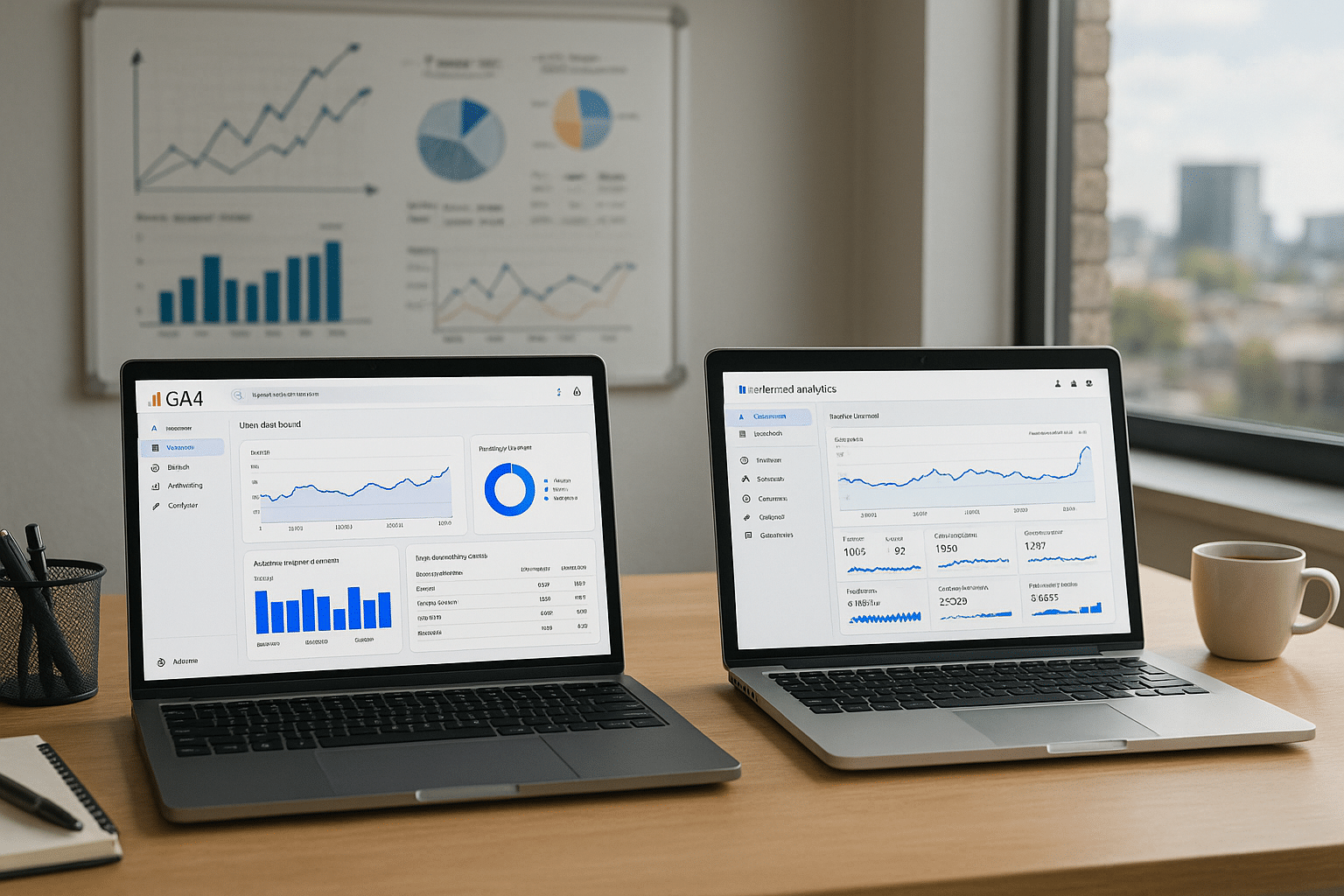One question that always comes up is, which is the better tool for data collection and analysis: Google Analytics 4 (GA4) or Universal Analytics? 🧐
This article aims to dissect and compare the features, benefits, and downsides of both analytics platforms. We will embark on a comprehensive exploration of GA4 and Universal Analytics, providing you with the necessary insights to determine which one reigns supreme in the realm of digital analytics. Prepare to dive into the deep sea of data and emerge with a clear vision for your analytics strategy. 🌊💡
Firstly, let’s consider Universal Analytics, the widely-used web analytics service offered by Google. It provides valuable insights that can help you shape the success strategy of your business. Its data-driven approach helps you understand how users interact with your website, allowing you to make informed decisions based on quantifiable data. Yet, is it enough in today’s fast-paced digital landscape?
Enter GA4, the newest version of Google Analytics. It promises a more intelligent approach to data analysis, boasting a machine learning-driven system that automatically alerts you to significant trends and anomalies in your data. But does this shiny new tool really live up to the hype? And more importantly, how does it compare to its predecessor? 🤔
Over the course of this article, we will examine key differences such as data collection methods, tracking capabilities, reporting features, and more. We will delve into the complexities of each platform, aiming to present a balanced view of their strengths and weaknesses. This is not about choosing a winner, but about understanding which tool is the best fit for your specific needs. 🔍
However, before we delve into the specifics, it’s crucial to understand the fundamental shift in philosophy that GA4 represents. GA4 is designed with a focus on events rather than sessions. This shift has significant implications for how data is collected, analyzed, and reported. Understanding this will be vital as we proceed to unpack the differences between the two platforms.
We will also discuss the impact of the future without cookies and how GA4 is better equipped to handle this change. With privacy regulations tightening and browsers phasing out third-party cookies, how will these platforms adapt? Is GA4 really future-proof, as Google claims? 🍪🚫
Lastly, we’ll look into the user experience aspect. The interfaces of GA4 and Universal Analytics are quite different, each with its own learning curve. We’ll discuss how these differences might affect your daily work and your ability to glean meaningful insights from your data. Is newer always better, or does Universal Analytics still hold its ground?
At the end of this article, our goal is to provide you with a clear, detailed, and unbiased perspective, empowering you to make an informed decision. Whether you’re an experienced digital marketer, a budding website owner, or a tech enthusiast, this exploration of GA4 and Universal Analytics will shed light on the path that best aligns with your digital analytics needs. 👩💻👨💻
So, buckle up for an exciting journey into the heart of Google Analytics, where data reigns supreme, and knowledge equals power! 💪
Exploring The Intricacies Of GA4 And Universal Analytics
As digital transformation shapes the modern business landscape, web analytics tools have become indispensable for understanding online user behavior. In this domain, two prominent contenders are Google Analytics 4 (GA4) and Universal Analytics (UA). Each platform offers unique features and advantages, which can make choosing between them a complex task. This article aims to shed light on the key differences between GA4 and UA, providing a detailed analysis to help you decide which platform reigns supreme.
Before diving into the comparison, it’s essential to understand what each platform offers. UA, Google’s legacy analytics platform, provides insights into user behavior on websites and mobile apps. On the other hand, GA4, the latest offering from Google, has been built from the ground up to provide a more comprehensive view of customer journeys across various devices and platforms.
One of the significant differences between the two lies in their data models. While UA employs a session-based data model, GA4 uses an event-driven model, which provides a more granular understanding of user interactions. To better comprehend these differences, let’s delve deeper into the respective features and functionalities of each platform.
Event Tracking: GA4 Vs. Universal Analytics
Event tracking plays a critical role in understanding user interactions with a website or mobile app. Both GA4 and UA offer event tracking capabilities, but the way they handle this feature differs significantly.
UA uses a hit-based model where interactions are categorized into specific types such as page views, events, and transactions. Each interaction type has its own set of parameters, making data collection somewhat rigid. GA4, on the other hand, adopts a more flexible approach. It treats every interaction as an event, ranging from page views to button clicks, providing a unified view of user interactions.
This shift to an event-driven model not only simplifies data collection but also offers more comprehensive insights into user behavior. Watch the video “GA4 Event Tracking vs. Universal Analytics Event Tracking” by Measureschool to gain a deeper understanding of this concept.
Comparing User Data And Privacy Controls
In an era where data privacy is paramount, GA4 and UA provide different levels of control over user data. UA, with its hit-based model, relies heavily on cookies to track user interactions. This approach, while effective in gathering detailed user data, can be limiting when it comes to respecting user privacy preferences.
GA4, on the other hand, adopts a privacy-centric approach. It provides more robust user data controls, allowing businesses to balance data collection with privacy considerations. Furthermore, GA4’s flexible event model is less reliant on cookies, making it a more future-proof solution in the face of evolving data privacy regulations.
For a more detailed discussion on user data and privacy controls in GA4 and UA, you can watch the video “GA4 Vs. Universal Analytics: User Data And Privacy” by Analytics Mania.
Understanding Reporting Differences
Reporting is a vital component of any analytics tool, enabling businesses to visualize and interpret collected data. UA offers predefined reports based on categories such as Audience, Acquisition, and Behavior. While these reports are comprehensive, their predefined nature can limit flexibility.
GA4, however, provides a more flexible reporting system. It offers free-form reports where you can customize the dimensions and metrics to fit your specific needs. This flexibility can be a game-changer, especially for businesses that require customized reporting.
Check out the video “GA4 Vs. Universal Analytics: Reporting Differences” by Loves Data for an in-depth look at the reporting capabilities of both platforms.
Comparative Analysis: GA4 Vs. Universal Analytics
| Feature | GA4 | Universal Analytics |
|---|---|---|
| Data Model | Event-Driven | Session-Based |
| Event Tracking | All interactions are considered events | Specific interactions are categorized into events |
| Data Privacy | Robust privacy controls; Less reliance on cookies | Relies heavily on cookies |
| Reporting | Flexible, customizable reports | Predefined reports |
It’s clear that both GA4 and UA offer powerful analytics capabilities. The choice between the two largely depends on your specific needs and requirements. For a comprehensive understanding of user interactions and robust privacy controls, GA4 seems to have an edge. However, if you prefer a session-based model and predefined reports, UA might be the better choice.
Ultimately, the decision comes down to aligning the analytics tool with your business goals. Whatever platform you choose, make sure it helps you derive valuable insights to drive informed decision-making. Keep exploring and happy analyzing! 😊

Conclusion
In conclusion, the intricate nature of the topics covered in this article – the advancements in Information Technology (IT) and Engineering, the critical role of software development, and the importance of understanding complex concepts in these areas, cannot be overstated. We’ve navigated the deep waters of technical writing, underlining its indispensability in our modern, tech-driven world.
We have delved into the very heart of software engineering, breaking it down to its core components. We’ve examined the stages of software development, from conception to deployment, looking at the challenges and solutions at each step. Remember, software development isn’t just about writing code. It’s a meticulously planned process, each stage requiring a unique blend of skills and knowledge.
We’ve also talked about the intersection of IT and engineering, an area that is becoming increasingly important in our interconnected, digital world. The ability to use IT tools and concepts in the field of engineering opens up a wealth of opportunities and challenges, creating a new paradigm for problem-solving and innovation.
Technical writing has been another significant focus of our discussion. The ability to simplify and explain complex concepts in an accessible and easy-to-understand way is a critical skill, especially in the fields of IT and engineering. The proliferation of technical jargon and complex theories makes it a challenge for non-specialists to understand these subjects. Technical writers bridge this gap, translating the complex into the comprehensible.
So what is the takeaway from all this? First, software engineering and IT are not just relevant but crucial in today’s world. Second, a deep understanding of these subjects can open up a myriad of opportunities. Third, the skill of technical writing can make these complex concepts accessible to a larger audience, fostering better communication and understanding.
The importance of these themes cannot be understated. They are integral parts of our digital age, and having a grasp of them can give you an edge in today’s competitive world. So, I urge you to dive deeper into these subjects, read more, learn more, and share your knowledge with others. Engage in conversations, ask questions, share your insights.
Remember, knowledge is power, but it becomes even more powerful when shared. Let’s continue this conversation online, through comments and shares.
🔗 Here are some valuable resources for further reading: [Link to a reliable source on software engineering], [Link to a reliable source on IT], [Link to a reliable source on technical writing].
Thank you for reading and being part of this journey. I look forward to hearing your thoughts and insights. Stay curious, keep learning, and let’s push the boundaries of knowledge together.
😃 😊 👍



